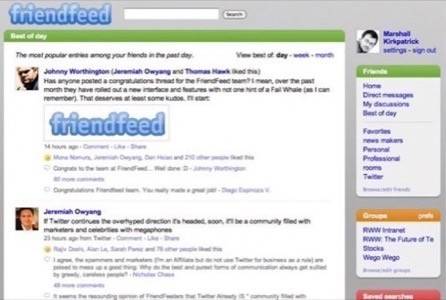Paul Buchheit built the first version of Gmail in one day. Then, he built the first prototype of Google’s contextual advertising service, Adsense, in one day as well. Now, he’s working on a much-watched startup called FriendFeed that he believes just brought to market the next big form of communication online: flowing, multi-person, real-time conversations.

“The open, realtime discussions that occur on FriendFeed,” he says, “are going to become a major new communication medium on the same level as email, IM and blogging.” That’s a pretty ambitious claim, but Buchheit has the credibility to make it.
The Early Days at Google
When Paul Buchheit was in college in the mid to late 90’s, he spent time working at both Microsoft and Sun. He classifies Microsoft as being in the “Religious Institutions Industry” on his LinkedIn profile, which is pretty funny. After graduating, he joined Intel for a year and then became the 23rd employee at Google (at the age of 23). He joined Google just 3 months after the company moved out of the garage of someone’s house and he stayed there for the next seven years.
Buchheit left Google in the middle of 2006, between the launch of Google Video and the acquisition of YouTube. Those probably weren’t of any concern to him, though. The same high stock price that made it possible for Google to pay the equivalent of $1.65 billion for YouTube presumably made the company’s 23rd employee, Buchheit, a very wealthy man.
Fast Forward to FriendFeed
Now Paul Buchheit is investing in new startups and has co-founded one of his own. FriendFeed is a fascinating combination of a.) an aggregation tool bringing information in from all around the web, b.) a big public conversation and c.) a publishing tool for original content. The service pulls in data from all the different social networks you tell it that you participate in, allowing your FriendFeed friends to see and discuss your activities on those networks whether they happen to participate in them or not.

For example, I don’t participate actively in the blog commenting network Disqus but Fred Wilson does. I follow Fred on FriendFeed, where he imports his Disqus comments automatically, so I can see and discuss that information on FriendFeed. There’s a long list of services that FriendFeed can import data from, from social bookmarking to YouTube favorites, but the majority of what goes on at the site is conversation about Twitter messages.
The FriendFeed team regularly rolls out new features faster than you can say “cross-platform microblogging aggregation,” but those cool features haven’t led to widespread adoption of the service yet. As tech blogger Michael Arrington points out, “the fact is that FriendFeed may just be too complicated for the average user to quickly understand… The power users love it. Novices can be overwhelmed.” Facebook also regularly implements the innovative features that FriendFeed comes up with and that certainly doesn’t help FriendFeed’s market share.
If you want to dive deep into the nitty gritty of how FriendFeed works, our podcast interview with Buchheit and co-founder Bret Taylor from more than a year ago remains one of the best ways to do so.
FriendFeed – Now!
This week FriendFeed pushed forward a radical redesign of the site based on a beta version it had been testing for just under a month.
The biggest changes were a new look and, most importantly, a real-time flow of information. Using a technology that Buchheit created in October called Long Polling, FriendFeed now streams all the information it finds from your friends down the page, just as soon as it finds it. Update: Many commenters have argued that this is just like IM or IRC. We’d argue that a fundamental difference is that real-time FriendFeed is about conversation tied to particular links or conversation threads.
David Chartier at ArsTechnica called the new version “more engaging and interactive.”
Dave Winer, one of the first movers in blogging, a key player in content syndication technologies and a big fan of FriendFeed, offered much harsher feedback. “I wonder if anyone uses the new FriendFeed for any serious purpose,” has asked, on FriendFeed. “Before I finish reading something, it’s scrolled off, replaced by the next thing. Feeding the whole write-only-ness of the medium. I anticipate even more mindless comments based on not having read the thing they’re commenting on. Now they have an excuse.”
Other power users have a laundry list of complaints. The simplified interface lost some of the most compelling features and made others harder to find. The service used to offer interesting data analysis like “who you find most interesting” and “who finds you most interesting.” Those options seem to be gone.
Buchheit told us that he believes “the appearance of our new interface is loved by many, and hated by others. Most people are probably somewhere in the middle.”
Is Real Time The Next Gmail?
Many social networking sites are moving towards real time information delivery instead of requiring page advancement or refreshing to find out what’s new. A year ago we called the real time nexus of Seesmic and Twhirl a vision of the future of the web. Twitter integrated real time search in February. Facebook made its newsfeed real time last month. Bleeding-edge media sharing network Enjoysthin.gs goes so far as to offer a real time view of activity only to paid members of its site!
Buchheit explains the paradigm’s appeal:
“Realtime is often an easier and more efficient way of communicating because an entire conversation can happen in a matter of minutes or seconds. It’s similar to the difference between a phone call and a series of voice mails — the phone call occurs in realtime so the entire conversation can often be concluded very quickly. It’s also critical for timely information — for example, on our internal FriendFeed group I may post a message about running an update on the live system, and it’s important that everyone see that message immediately.
“One of the advantages of FriendFeed over other realtime systems such as IM is that it also works non-realtime. For example, at the end of the day I’ll often browse my “best of day” view to see what the top stories and discussions of the day were.”
That makes sense to me. Though real time conversations can feel overwhelming, the pause button on the Friend Feed site should help and in time I expect we’ll all get used to it. There was a time when I felt totally overwhelmed by Twitter, and the discovery of what RSS feeds can deliver to a feed reader left me in a daze for weeks (and led to a new career).
Enterprise adoption of real time communication in general and FriendFeed in particular are topics that some people are discussing. Sameer Patel has written a lengthy article exploring the potential for using FriendFeed in the enterprise and we’ve heard of several companies using the service as a lightweight intranet.
The Future of FriendFeed
Things are changing fast at FriendFeed. Buchheit says that the company believes aggregation to be less important than real time conversation. “The open, realtime discussions that occur on FriendFeed are going to become a major new communication medium on the same level as email, IM and blogging. The aggregation component of FriendFeed is a convinient feature and a component of that openness, but not as central as the discussions.”
People have complained for some time that all the different sources of information and long list of features make the service confusing for new users. Tackling that problem was a key element of the new redesign.
“It’s very important that new users can look at the product and immediately understand what’s going on and how to use it,” Buchheit told us. “The new User Interface is much more straightforward because all they see is a list of messages and comments from friends, and a box for posting new things. Over time, they are able to discover other features (such as groups, saved searches, imported feed, etc), but those things aren’t part of the initial experience.”
Many early adopters of the service really don’t like what the company has done with its website. Buchheit says that they will soon have far more control over customizing the experience.
“Visual design is clearly a very personal thing — the appearance of our new interface is loved by many, and hated by others (though most people are probably somewhere in the middle). This is why one of the goals of the new design was to accomodate skinning/themes. We don’t yet know the exact timing of the release, but we hope to have a version 1 of themes available in a matter of weeks.”
The Big Picture
So, here’s a summary. The father of the best web email program on the planet believes that a real-time streaming interface for simplified aggregation of conversation and content from all around the web is going to join the handful of tools we use regularly, like email, IM and blogging.
The biggest question still remaining? Facebook. Buchheit on Facebook:
“Facebook is still very much a closed world of its own. That’s sometimes useful, but other times I want the ability to interact with the outside world and also other systems. For example, if I post something on FriendFeed about a product that I’m using, often someone working on that product (or very knowledgeable about it) will join in on the conversation. That kind of thing can’t happen on Facebook. [Because cross-site search is limited by default privacy restrictions. -ed.] FriendFeed also interoperates much more smoothly with other systems, so I can easily import my blog posts, receive updates via email or IM, or post messages on to Twitter. Things I post on Facebook are not allowed to leave Facebook (except under very strict terms that require deletion within 24 hours, which is why clients such as Seesmic can interface with it, but services such as FriendFeed have a harder time).”
Do you buy that? I’m not sure. But if anyone can lead the charge against incumbent technologies with a new paradigm that combines powerful richness and ease of use – Paul Buchheit might be that person. He did it with Gmail, now time will tell if he can do it with FriendFeed.










